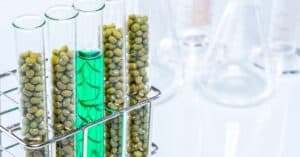Read this article to know what GMO seeds mean, why people are concerned with GMOs, and how to know are microgreens genetically modified or not.
Gardening your own food gives you fresh, affordable, and nutritious produce to include in meals and snacks. Microgreens have gained popularity as tiny, but nutrient-packed plants that can add a lot to homemade dishes. Before putting anything on your plate and in your body (not to mention giving it valuable and limited garden space!), you want to know what it is and where it is coming from.
Most microgreens are not genetically modified organisms. Microgreen seeds that are certified non-GMO are highly available and easy to find. Microgreens are small because they are harvested young, rather than because they are modified to be so.
Growing microgreens is simple for experienced gardeners and even beginners! The early harvest makes the process short and easy. This article will make finding the best seeds to grow your microgreens just as simple.
What Does GMO Mean?
You may have heard the terms genetically modified organisms, or GMOs, thrown around in all sorts of contexts, but what exactly do they refer to?
As defined by the U.S. Department of Agriculture, GMOs are “an organism produced through genetic modification.”
Genetic modification is defined by the U.S. Department of Agriculture as “the production of heritable improvements in plants or animals for specific uses, via either genetic engineering or other more traditional methods. Some countries other than the United States use this term to refer specifically to genetic engineering.”
More simply, GMOs are the products of genetic modification. Genetic modification is any process where man manipulates the DNA of an organism. Conventional breeding combines the genes of two organisms. While you can choose to mate two organisms with the desired traits, the offspring is assigned characteristics by random. Genetic modification involves targeting in on a trait and the genetic sequence behind it.
GMOs often have their DNA altered using the genetic material from another organism. For example, fruit hybrids may combine the flavor of one fruit with the heartiness of another. The result is a fruit that is easier to grow and lasts longer but tastes better.
In plants, mostly produce, the variables which determine how a product sells and how much it costs to produce are directly related to profit. That makes these variables the focus on genetic modification to increase profits and reducing waste. This includes using genetic modification to produce consistent flavor, resistance to pests, resistance to disease. Better growing conditions lessen the expenditure of natural resources and fossil fuels during the harvesting process and deliver more nutritional value.
Why Do People Care about GMO Foods?
GMOs carry lots of potential benefits. These include increased food production for a growing population, less waste during farming and after harvest, less need for harmful herbicide and pesticides while farming, and new varieties of food. Yet, there is still a mass of controversy around GMOs, especially in the foods people eat.
Anti-GMO activists warn of environmental damage and potential health consequences.

The issue of environmental damage creates an ethical dilemma. Is food production worth the cost of environmental damage? Many consumers do not feel it is and avoids purchasing GMO products accordingly. Some ecological issue is the GMO version of a crop causing extinction of the original variety and the growth of herbicide-resistant weeds.
Potential health consequences are highly debated. Many anti-GMO activists and organizations claim GMO foods to be directly harmful to the health of those who consume them. However, much of the research finds little to no difference in the consumption of GMO and non-GMO versions of the same foods. One example is this publication put out by the American Association for the Advancement of Science.
Are Microgreens GMOs?
Microgreens and microgreen seeds are mostly non-GMO. Finding non-GMO microgreen seeds is relatively easy, with many options available on the market.
The following are some brands that sell non-GMO microgreen seeds.
Ecovoo’s microgreen seeds come with simple instructions for growing, promise quick germination, and are non-GMO. They can be purchased in different varieties to get your non-GMO microgreen garden started.
This pack from Rainbow Heirloom Seed Co. contains a mix of microgreens from a variety of plants, all of which are non-GMO. This is a great way to get started with microgreens and try a variety in your diet, all with the guarantee on no GMOs.
This kit offers variety while allowing you to organize your microgreens and know which are which. The kit comes with five different packets, all from different plants, and all non-GMO.
Many of the microgreen seeds you come across will be non-GMO, whether you prioritize this or not. With a short growing period and low yield for large scale farming, the benefits of genetically modifying microgreens are much less than mass-produced plants like soy and corn.
How to Spot GMO and non-GMO
In 2019 the National Bioengineered Food Disclosure Standard was passed. This law is made so that by January 2022, all food with more than 5% bioengineered material must be labeled with a bioengineered label. While this law does not fully take effect until 2022, some companies have begun to incorporate the label on their products from over 5% bioengineered material. If buying microgreens already grown, this can be helpful to look out for.
Whole Foods Market was ahead of this law in 2018 when they required all products that have contained GMOs to have labeling indicat

ing such. This made Whole Foods the first national grocery store to set definitive, timely regulations for GMO transparency. If you have a local Whole Foods Market, their policies make it easy to know your microgreens are non-GMO.
Companies may use the non-GMO label from the Non-GMO Project. This label means the product has been evaluated for compliance with the non-GMO Project’s Standard. In the absence of a U.S. law requiring GMO related disclosure, this label has been what non-GMO shoppers have relied on.
When buying seeds to plant your own microgreens, the best way to make sure a company is selling non-GMO seeds is to look into the company you are buying from. This may take a bit more time than simply looking for a label, but if non-GMO is vital in your garden, it is worth the time. It can take no more than a quick google search and scroll through their website.
Look for a company’s testimonial, any signed pledges to organic or non-GMO seeds, and organic certifications. If a company does not clearly state where they stand or show any of the listed resources for proof, it is not reliable to assume they are non-GMO. Non-GMO seed producers are often proud and eager to be transparent about their seed production practices.
Take Away
Microgreens are easy to grow, easy to incorporate into meals, and make all the difference in a beautiful presentation! Of course, these little guys also add lots of nutrition value to any plate. Do not let GMOs discourage you from making room in your garden for some fresh microgreens. GMOs are taking up more space and store shelves than ever before.
The production method is still in need of further research to dispute controversies and gain the trust of many consumers. Nevertheless, what you choose to grow and to eat is entirely up to you. You should be able to get full transparency from brands and make informed decisions.
Luckily, many seeds come from those who appreciate the practice of farming and fresh, nutritious foods. Microgreens are no exception to this. These brands make their statements clear and allow customers to grow precisely the foods they want.

